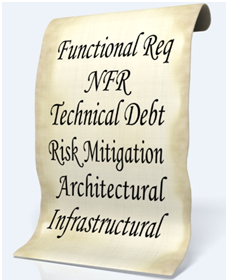“What” needs to be done in Scrum are called Backlog. Product Backlog is everything that is yet to be done and not necessarily the activities that the team has fallen behind.
The product backlog is an ordered list of requirements that is maintained for a product. It consists of features, bug fixes, non-functional requirements, etc.—whatever needs to be done in order to successfully deliver a viable product. The product backlog items (PBIs) are ordered by the Product Owner based on considerations like risk, business value, dependencies, date needed, etc.
The product backlog contains the Product Owner’s assessment of business value and the Development Team’s assessment of development effort.
The product backlog and the business value of each backlog item is the responsibility of the Product Owner.
The size (i.e. estimated complexity or effort) of each backlog item is, however, determined by the Development Team, who contributes by sizing items, either in story points or in estimated hours.Backlog is everything that is yet to be done and not necessarily the activities that the team has fallen behind.
- The product backlog is an ordered list of requirements that is maintained for a product.
- It consists of features, bug fixes, non-functional requirements, etc.—whatever needs to be done in order to successfully deliver a viable product. The product backlog items (PBIs) are ordered by the Product Owner based on considerations like risk, business value, dependencies, date needed, etc.
- Items added to a backlog are commonly written in story format. The product backlog is what will be delivered, ordered into the sequence in which it should be delivered. It is open and editable by anyone, but the Product Owner is ultimately responsible for ordering the items on the backlog for the Development Team to choose.
- The product backlog contains the Product Owner’s assessment of business value and the Development Team’s assessment of development effort, which are often, but not always, stated in story points. These estimates help the Product Owner to gauge the timeline and may influence ordering of backlog items.
- The product backlog and the business value of each backlog item is the responsibility of the Product Owner. The size (i.e. estimated complexity or effort) of each backlog item is, however, determined by the Development Team, who contributes by sizing items, either in story points or in estimated hours.
- Scrum advocates that the role of Product Owner be assigned. The Product Owner is responsible for maximizing the value of the product and the work of the Development Team. The Product Owner gathers input, takes feedback and is lobbied by many people, but it will ultimately make the call on what gets built. Product Owner is solely responsible for the management of the backlog.
- Ideally the Product owner needs to have clarity of all requirements that need to be taken up in the next 2 or 3 sprints. The rest of the stories could be kept at a fairly high level. The Backlog Grooming Sessions during the Sprints are used to get clarity on the backlog items which are not clear.
- A Backlog is a live document or list that the Product owner continuously updates
| Example
Let us look at a small list of items that could be part of a Product Backlog. Each item in the backlog is essentially a short description of a requirement to meet the need of the customer or add value to customer. Let us consider a ticket booking system project
The description is provided by the product Owner in consultation with the stakeholders. The size is expressed in some units and is provided by the team. The Size will be discussed in more detail when we discuss estimation. Backlog items could be · Functional Requirements (items 1,2 in the above table) · Non Functional Requirements (item 4 in the above table) · Bug Fixes (Item 3 in the above table) · Upgrades (Item 6,7 in the above table) |
In short any work that team could do for the customer should be routed thru the backlog.
Let us list down the different Backlogs
- Product Backlog
- Product Backlog may contain “Epics” and “User Stories”
- Release Backlog : Release Backlog is a subset of Product Backlogand represents the items that the team has agreed to implement within a given release of Product
- A sprint Backlog is a subset of Release Backlog and represents the items that team has agreed to implement within a given Sprint
- Release Backlog is typically in terms of “User Stories”
- Sprint Backlog may further breakdown specific Stories into tasks (sometimes called Sub-Stories) that need to be accomplished
Characteristics of Product Backlog
The Product Backlog has four qualities.
DETAILED appropriately
ESTIMABLE
EMERGENT
PRORITIZED
- Detailed Appropriately : The product backlog items are detailed appropriately. The higher order items are described in more details then the lower priority items. Following this guideline keeps the backlog consise and ensures that the items likely to be implemented in the next sprint are workable. As a consequence, the requirements are discovered, decomposed, and refined throughout the entire project.
- Estimated : The product backlog items are estimated. The estimates are coarse-grained and often expressed in story points or ideal days. Knowing the size of the items helps prioritize them and plan the release.
- The Product backlog has an organic quality. It evolves and its contents change frequently. New items are discovered and added to the backlog based on customer and user feedback. Existing items are modified, reprioritized, refined or removed on an ongoing basis.
- All items in the product backlog are prioritized. The most important and highest-priority items are implemented first. They can be found at the top of the product backlog. Once an item is done it is removed from the product backlog.
Elements of Product Backlog
Product Backlog is not just the functional items. Product Backlog may contain many other types of requirements,
- Infrastructural Items
- Architectural elements
- Technical Debts
- Non Functional elements
- Security elements
- etc
A Video on Product Backlog Metaphor – Iceberg
Product Backlog is a Dynamic List – It Emerges
Product Backlog Items are dynamic. That means they keep emerging as clarity comes. Remember, Scrum is based on Empirical Process Control. Unless and until once tries, how can clarity emerge. The reason why we use Scrum is to handle complex work – and complexity means unknownness.

